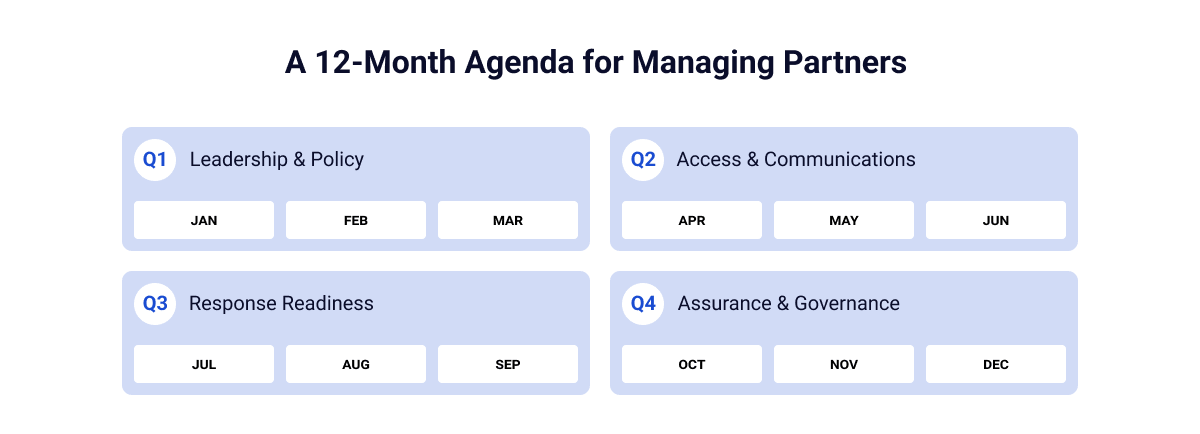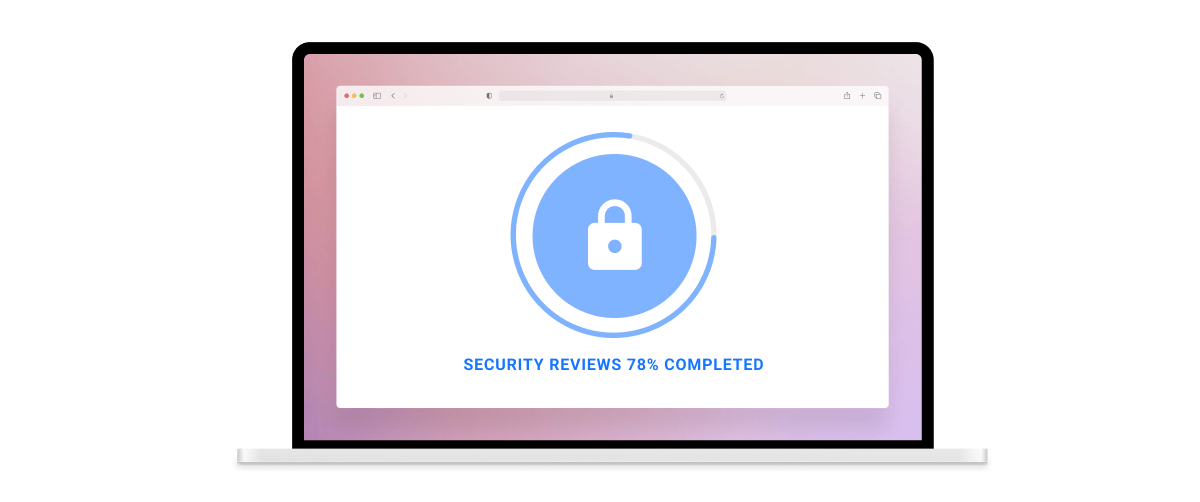

By 2026, a firm’s “digital trust”—how securely and responsibly it manages data—will be just as important to clients as its legal expertise. General counsel and legal operations leaders are placing greater emphasis on how safely and ethically matters are managed, not just on outcomes.
With hybrid work now standard, cloud vendors integrated into daily practice, and AI and cybersecurity in law firms becoming inseparable from daily operations, firms have an opportunity to make security a visible part of their value. When they can clearly communicate their safeguards and demonstrate accountability, security shifts from a background function to a competitive advantage for winning and retaining clients.
Law firms continue to be prime targets for cyberattacks because they store highly sensitive, high-value information. Recent data shows attackers are increasingly exploiting software vulnerabilities, with ransomware in the legal sector appearing in about 44% of breaches and third-party involvement doubling year over year. In 2024 alone, reported U.S. cybercrime losses reached a record $16.6 billion, while ransomware complaints to the FBI rose 9%, underscoring the growing threat of digital extortion.

Within the legal industry cybersecurity landscape, preparedness is mixed. Surveys show that 4 in 10 firms have experienced a security breach, yet only 26% feel very confident in their ability to handle future threats. Beyond data breaches, the exposure is even greater. According to cybersecurity firm Trustwave, law firms accounted for 46% of all ransomware attacks on professional service providers in 2024, making them the industry’s top target. Despite growing awareness of these risks, many firms still fall short when it comes to modern defense.
Too many firms still rely on traditional firewall defenses—tools designed for a time when threats came from outside the network. But today’s attackers don’t always need to “break in.” They often log in.
Modern cyberattacks increasingly target identities, credentials, and trusted connections instead of trying to breach perimeter walls. Once attackers gain access through a stolen password, compromised VPN, or cloud account, they can move freely inside systems, often using legitimate administrative tools to avoid detection.
U.S. agencies have repeatedly warned about these tactics. The 2024 Cybersecurity and Infrastructure Security Agency (CISA) advisory, for example, highlights ongoing campaigns that exploit valid login credentials and misuse common IT and security software to bypass traditional network defenses entirely.
In this environment, relying on firewalls alone is like locking the front door while leaving all the interior doors wide open. Firms need layered defenses—strong authentication, device checks, and continuous monitoring—to detect unusual activity even after access is granted.
This shift represents a key part of law firm data breach prevention, where identity and access management become central to protecting sensitive client information.
Artificial Intelligence (AI) and Generative AI tools have quickly become part of everyday legal work, helping lawyers draft, summarize, and analyze legal documents and medical records with unprecedented speed. But without clear policies, governance, and audit trails, they can also create new confidentiality risks, especially when sensitive client data is entered into systems that store or reuse information.
The National Institute of Standards and Technology (NIST) AI Risk Management Framework offers practical guidance for managing these risks, emphasizing the need for documented governance, measurable controls, and continuous monitoring throughout the AI lifecycle. SimilarlyTo, the American Bar Association (ABA) has issued an ethical guidance on AI that reinforces that lawyers must supervise the technology they use, understand how vendors handle data, and be transparent with clients about when and how AI is involved.
As firms update their security and governance strategies for 2026, a few clear priorities are emerging. These shifts reflect how client expectations, technology adoption, and regulatory focus are evolving, and where firms can align their investments for the greatest impact. Here’s where to focus next:
These shifts reflect how data privacy for law firms and client trust will define competitive advantage going forward.
Work today happens everywhere: at home, in hotels, on shared devices, and on the move. That flexibility has become permanent, which means security must also travel. Firms can strengthen protection without sacrificing usability by applying production-grade safeguards wherever people work.
Device health can serve as a quiet but effective checkpoint for client data. If a laptop or phone isn’t patched, encrypted, or monitored, it shouldn’t connect until it meets baseline standards. This approach mirrors the 2023 NIST guidance on mobile security, which focuses on clear policies, app controls, and ongoing monitoring.
Vendor diligence is another area where firms often move too quickly. Agreements that lack clear terms on data handling, breach notification, or third-party access can shift risk downstream, leaving clients exposed. Even when security controls are robust, they’re often invisible to clients—something that can quietly erode trust.
The ABA’s 2021 opinion on virtual practice reminds firms that “reasonable efforts” to secure communications apply wherever work happens, whether in the office, at home, or on the road. That means bringing the same rigor to vendor relationships and technology oversight as you would to your internal systems.
Vendor diligence works when it is specific and testable. Clarify who can see your data, under which roles, and from which locations. Specify encryption in transit and at rest. Set clear deadlines for reporting a breach and for saving related proof. Demand transparency on sub-contractor security standards. Require notice for security-relevant changes, with consent for high-risk shifts. Tailor indemnity to confidentiality and data-protection risks. Make clear where data resides and how it is shared, including format, completeness, and timeline.
AI now touches nearly every stage of legal work, from intake and drafting to legal research, discovery, and client communication. As adoption grows, firms must learn how to balance innovation with the responsibilities that come with handling sensitive information. The goal isn’t to slow progress, but to build the right guardrails so teams can move quickly and confidently.
A practical approach starts with approved AI tools that align with the firm’s security standards and appetite for risk. Clear agreements and transparency about how data is handled helps to maintain trust. Testing tools before deployment can also reveal issues like inaccurate outputs or potential data exposure early on, before they affect real work.

Consider the following best practices for law firms implementing AI in their firms:
Building a stronger foundation for privacy, security, and responsible AI use requires a deliberate plan. The following 12-month agenda outlines practical steps firm leaders can take to strengthen governance, improve resilience, and demonstrate accountability to clients and regulators alike.

Effective metrics do two things: they verify that people are following security policies in practice, and they show whether those efforts are improving outcomes for clients and the firm. The goal isn’t to track everything. Rather, it’s to focus on a small set of meaningful indicators that can be monitored consistently and acted on quickly.
Leading indicators are early signals that show whether your controls and behaviors are on the right track. They measure the inputs: the actions, habits, and safeguards that help prevent issues before they occur. The following are examples of leading indicators:
Lagging indicators, on the other hand, measure outcomes. These are the results of those actions over time. They show how well your systems and processes perform when tested by real events. The following are examples of lagging indicators:
The ultimate measure is whether win rates and retention improve when clients cite security and data stewardship as reasons to engage.

A plain-English framework can help clients understand how you manage data privacy and uphold ethical handling of information. The following six pillars form the backbone of a secure, trustworthy operation:
Together, these pillars create a foundation for lasting client confidence, transforming security from a technical obligation into a visible part of the firm’s reputation and competitive strength.
Firms that lead in 2026 will make confidentiality and compliance visible, verifiable, and part of the client experience from engagement letter to final invoice. Explain your controls, prove your readiness, and teach clients how to be safe while working with your team. When clients can see and feel your protections at every step, trust compounds—and that trust becomes a durable advantage.
DigitalOwl is the leading platform for AI-powered medical record reviews for insurance and legal professionals. As a trusted partner in managing sensitive information, our platform is built with security and compliance at its core, ensuring every record is protected to the highest standards. Learn more about our security practices at our Trust Center.